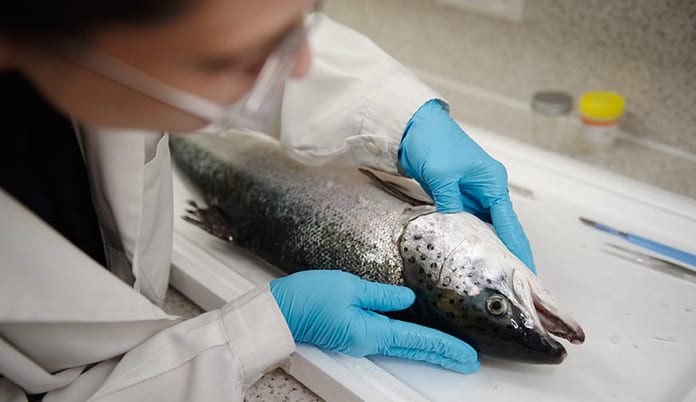Annual cardiomyopathy syndrome costs to salmon farmers in Norway alone estimated at €145 million.
According to a press release issued on behalf of the Sustainable Aquaculture Innovation Centre (SAIC) on Thursday, a group of researchers in Scotland are undertaking a project that will aim to develop a simple and cost-effective mass testing tool to detect a range of cardiac conditions in salmon.
Developing a non-lethal mass testing system for cardiomyopathies could make a substantial difference to a growing challenge in the aquaculture sector. During 2018 in Norway, cardiomyopathy syndrome alone was considered one of the biggest issues for fish farmers, with associated costs estimated at €145 million.
The consortium will seek to better screen and characterise the heart health of salmon by studying specific blood biomarkers that indicate the presence of cardiomyopathies such as heart and skeletal muscle inflammation (HSMI), cardiomyopathy syndrome (CMS), and pancreas disease (PD). Assessing the diseases with high precision is difficult with current diagnostic techniques, particularly when they are at their early stages.
The tests – which they claim will be able to return results in 45 minutes – could help producers to understand how fish are affected and inform best stock management choices, as well as identifying fish with greater physiological resistance to cardiomyopathies.
Bringing together experts from the University of Glasgow, University of Edinburgh, Cooke Aquaculture Scotland, Life Diagnostics Ltd, Moredun Research Institute, Benchmark Genetics Ltd, and the Sustainable Aquaculture Innovation Centre (SAIC), the project aims to deliver a new tool that is simple to use for fish health professionals, easily deployable at fish farms, and brings immediate and practical advantages in disease prevention, earlier treatment, stock management, and breeding for disease resistance.
Philippe Sourd, senior veterinarian at Cooke Aquaculture Scotland, said: “The aquaculture sector is science-led and as responsible salmon producers we are constantly looking at practical innovation that maximises fish health and welfare. This project could equip us with the tools to conduct meaningful population health screening at pen or farm level, which will further increase our understanding of salmon cardiac health patterns.”
Sourd added, “Obtaining real-time data, along with reliable and accurate information on the condition of our salmon stock, is a priority as it enables effective decision-making processes and early intervention to promote the health, wellbeing, and performance of our livestock. By working with academic partners to prove the diagnostic tools, we believe this technology can benefit salmon farmers – and potentially fish farmers in general – as an essential tool to drive fish health and wellbeing strategies.”



